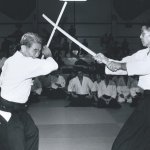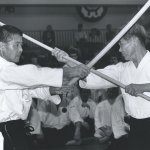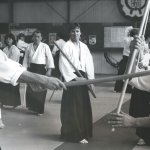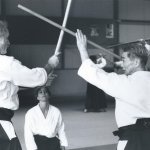A lot of experts in Aikido improved and modified their practice through the learning of arms: Katana, Ïaito, Bokken and Jo. It was the case of Saito Sensei, Chiba Sensei and a lot more. However, for Nishio Sensei, the integrality of his work was enlightened and structured by the weapon techniques.

He had been allowed very early (in 1965) to create its own saber sword school known as Aïkido Toho laï, meaning “implementation of Aïki principle with the saber sword”. Indeed, every Kata is connected to a basic movement of Aïkido or reveals a basic principle of Aïki : Irimi, Musubi, etc...
On O Sensei’s advice, he’s started since 1955 the study of the Ïaido MUSO JIKI DEN EISHIN Ryu and the Jodo SHINTO MUSO Ryu. Afterwards, he practiced in other Ïaïdo and Jo do schools. Both practices were complementary: Ïaïdo schools including Jo Do teaching or both schools using the same dojo.
His Jo practice comes from this source: the Jodo. As a matter of fact, it’s fundamentally different from the traditional Jo practice, as it’s known usually in Aïkido, specially in Europe.
Within the European Federations of Aïkido, the “Jo-taï-Jo” practice is almost the only one taught. It has been spread by the teaching of Saïto Sensei among others, his videos and books.
The Jo-taï-jo art, also called Aïki-jo, has been widely taught in Europe by experts such as Chiba Sensei and Tamura sensei, to mention just a few.
But the use of a Jo in a JODO context is completely different. The Jo becomes exclusively a mean to counter or fight an opponent armed with a saber sword.
When it’s adapted to a safer and more accessible teaching than fighting a Katana with a Jo, the Jo-taï-Ken becomes the favored form in the JO DO schools. It’s also the only form of Jo taught by Nishio Sensei.
We distinguish three major changes concerning the manipulation of the Jo compared to the Jo-taï-Jo: The stances, the strikes, the manipulation technique.

The stance, Kamae
While in Jo-taï-Jo the initial stance is to place the Jo vertically to the ground in front of the body, in Kamae with the left foot ahead and the left hand holding the Jo at hips height, this stance doesn’t exist in Jo-Do and therefore was disapproved by Nishio Sensei.
The first property of the stance, as it’s taught, is to hide the length of the Jo for its holder. In the past the length was variable and not standardized to 1.28 meter. Consequently, the Jo was to be hold by the left hand or the right hand at the middle of the Jo, in a way that the Jo gets inclined slightly to the horizontal line, so that the axis of the arm can get directed towards the left eye of the opponent armed with a Ken. (cf. Photo 1). The left eye and not the right eye! We can easily connect this remark to our modern knowledge of the different roles of the two brain hemispheres and their inverted control on each part of the body.
There are other stances – still with the Jo on the right side or on the left side of the hip – that include the grip of both hands but keep the same objectives: hiding the length of the Jo and allowing an immediate use of the weapon.

The strikes
Strikes with a Jo taught by Nishio Sensei were also fundamentally different from those practiced in traditional Aikido (in Jo-taï-Jo).
In Jo-taï-Jo, the striking force used to be find through the use of the stick inertia and a large curving radius through the action, therefore a very large extension of the movement. But the Jo strikes of Nishio Sensei (Shomen, Yokomen, Kesa) was made with no apparent preparation, but with a closed grip of both hands sliding along the Jo.
This particular strike supposed first of all to be “armed” by an opening of the hand on the Jo. (Photos 2, 6, 20, 21). Thus, it was basically strikes made by a closing of the hands “sliding” along the Jo. This movement came necessarily with a hip movement, even if it was unperceivable.
These very quick and powerful strikes, include a first contact with the saber sword in a very slight angle (almost tangent to the trajectory of the saber sword cut, cf. photos 7, 31, 32). They were made to chase the Ken – instead of cutting the Jo- when executed in action.
Very often, these strikes also aimed directly the opponent armed with a Ken. Then, just like in traditional Aïki-Jo, it was weither a bone part or a joint part of the body that was targeted : elbow, knees, wrist... (Photos 2, 5, 16).
Nishio Sensei was able to strike at an exceptional speed that no one could imitate, not even his most talented assistant (cf. videos on : www.aikido-paul-muller.com ).
One last point that characterizes this work is the hands position when striking. Very often the hands were joint which let a 25 to 35 cm length of the Jo unused. It reduced the “useful” length of the Jo more or less to the length oh the Ken of the opponent. This was one of the way to reach a maximal speed when striking, specially for the rotation strikes (as Kata Dori Menuchi Nikio in Jo-taï-ken).
The "living" Jo
In the Jo handling, the additional symmetries of the wooden stick compared to the saber sword were constantly used – which is also supposed to be the case in traditional Aïki-Jo - .
The hands were opening and closing on the Jo that was constantly used with one or another end, letting impossible to guess which side was about to strike before the action was executed. The Jo then seemed to be alive.
Above this almost magical handling of the Jo, the perfection of the unity of the Sensei with his arm and the perfect harmony resulting of it, let the spectators and trainee fascinated, in high spirits.
All his Japanese, American and European pupils pursue his path. But if we look at videos of his performance, armed or unarmed, it must be concluded that there’s still a long way to go.
This is the fate of many of Budo practitioners who had the chance to work with an exceptional master. Nishio Sensei was an exceptional master when it comes to the Jo, the saber sword and Aïkido.
Paul Muller 7° Dan Aïkikaï Tokyo.
Cf. the website www.aikido-paul-muller.com where you can find a lot of videos about Nishio Sensei and his work.









